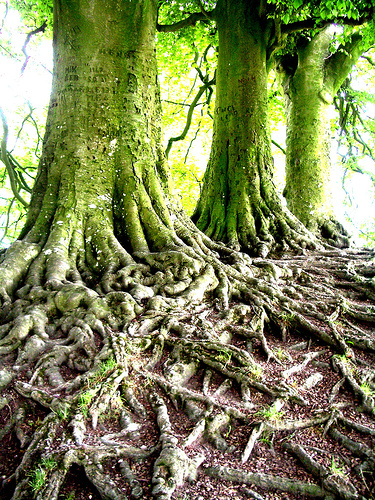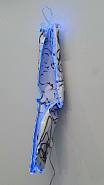
" The scientific approach to the examination of phenomena is a defence against the pure emotion of fear. Keep tight hold and continue while there's time" (17).



In Tony's already confused world of magic versus religion, the Golden Carp signifies yet one more source for his doubts about Christianity. Cico introduces Tony to the Golden Carp, a pagan god who is a symbol of forgiveness, unlike the Christian God who Tony believes is cruel and unforgiving. The carp is beautiful and huge, a true source of awe. At the realization that, contrary to Christian belief, there are other gods, Tony begins to question who his mother is truly praying to- who is Jesus, who is the Virgen de Guadalupe? Tony's doubts about Christianity further deepen when he makes his First Holy Communion, a religious rite of passage in Catholicism where children eat God's body in the form of a wafer. Antonio expects to hear the voice of God at the moment the takes the Eucharist into his body. He expects that this will be a monumental event and that everything will be clear to him after that. After nothing happens, Tony is utterly disappointed. He wonders why he can see the carp and not God. Tony begins to believe that God may not be real because he is intangible, whereas the carp is easily recognized because it is a physical item; "The orange of the golden carp appeared at the edge of the pond. As he came out of the darkness of the pond the sun caught his shiny scales and the light reflected orange and yellow and red. He swam very close to our feet. His body was round and smooth in the clear water. We watched in silence at the beauty and grandeur of the great fish" (p. 115).











 "My love for Linton is like the foliage in the woods: time will change it, I'm well aware, as winter changes the trees. My love for Heathcliff resembles the eternal rocks beneath: a source of little visible delight, but necessary. Nelly, I am Heathcliff!" (80).
"My love for Linton is like the foliage in the woods: time will change it, I'm well aware, as winter changes the trees. My love for Heathcliff resembles the eternal rocks beneath: a source of little visible delight, but necessary. Nelly, I am Heathcliff!" (80). sping for air. But they were already tearing the Chaplain from my grip" (121-122).
sping for air. But they were already tearing the Chaplain from my grip" (121-122).

 The image is of the Virgin of Guadalupe or Christianity's mother Mary, framed by two moons and a crown of thorns. It represents the beauty of the protagonist's search for faith and religious sanctity in his surroundings including his mother's unwavering faith in the church, his grandmother-figure's wisdom in the ways of the earth, and the terribly awesome power of mother nature. Placed in the lower left corner of the image is the main character, Antonio Marez, blending in with the color that binds the image and makes it whole. He is but a young boy searching for religious peace when the story begins and continues through his experiences with his surroundings and heritage. The explanations he seeks to remedy his pious, humble confusion are brought to him in dreams; his subconscious attempts to make sense of the beliefs surrounding him by conveying "The waters are one...You have been seeing only parts , she [the Virgin of Guadalupe] finished, and not looking beyond into the great cycle that binds us all" (Anaya 121). Antonio was at a loss to connect the beliefs and faiths that he was absorbing through his childhood. His mother believed in salvation through the church, his father through the blood of his ancestors within the river, his friends, a "Pagan" carp that created life, and his grand-mother figure Ultima, an herbal healer of sorts. The dream tells him that these beliefs are true, none of them are right, wrong, or superior to one another. This forces Antonio to pick his own independent path of religious faith without any influence, allowing him to finally grow into himself and become a man by his own standards and not society's, which seem so lost. It is the only way Antonio can find internal peace and not be "lost to the sin's of his people."
The image is of the Virgin of Guadalupe or Christianity's mother Mary, framed by two moons and a crown of thorns. It represents the beauty of the protagonist's search for faith and religious sanctity in his surroundings including his mother's unwavering faith in the church, his grandmother-figure's wisdom in the ways of the earth, and the terribly awesome power of mother nature. Placed in the lower left corner of the image is the main character, Antonio Marez, blending in with the color that binds the image and makes it whole. He is but a young boy searching for religious peace when the story begins and continues through his experiences with his surroundings and heritage. The explanations he seeks to remedy his pious, humble confusion are brought to him in dreams; his subconscious attempts to make sense of the beliefs surrounding him by conveying "The waters are one...You have been seeing only parts , she [the Virgin of Guadalupe] finished, and not looking beyond into the great cycle that binds us all" (Anaya 121). Antonio was at a loss to connect the beliefs and faiths that he was absorbing through his childhood. His mother believed in salvation through the church, his father through the blood of his ancestors within the river, his friends, a "Pagan" carp that created life, and his grand-mother figure Ultima, an herbal healer of sorts. The dream tells him that these beliefs are true, none of them are right, wrong, or superior to one another. This forces Antonio to pick his own independent path of religious faith without any influence, allowing him to finally grow into himself and become a man by his own standards and not society's, which seem so lost. It is the only way Antonio can find internal peace and not be "lost to the sin's of his people."

 "Throughout the whole absurd life I'd lived, a dark wind had been rising toward me from somewhere deep in my future, across years that were still to come, and as it passed, this wind leveled whatever was offered to me at the time, in years no more real than the ones I was living" (Camus 121).
"Throughout the whole absurd life I'd lived, a dark wind had been rising toward me from somewhere deep in my future, across years that were still to come, and as it passed, this wind leveled whatever was offered to me at the time, in years no more real than the ones I was living" (Camus 121).

